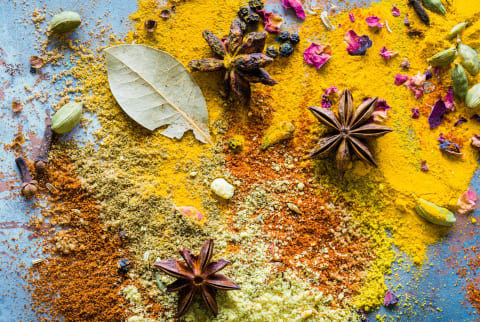Advertisement
5 Things Everyone Gets Wrong About Using Ayurveda To Heal Digestion & More


Ayurveda is gaining prominence in the mainstream, as yoga becomes increasingly popular, and fashionable eateries serve turmeric lattes (aka Golden Milk) and bliss balls (aka Ladoos). That said, many people in the West are still confused about this ancient philosophy and how to integrate it into their everyday. Since releasing my ayurveda-based cookbook East by West, I've found that people often have a lot of misunderstandings about what ayurveda actually is. Here are the top five myths, busted:
1. It's a "woo-woo" fad.
Ayurveda is a health system that originated in India 5,000 years ago and is still used to prevent and cure disease in South Asia and around the world, keeping our minds, bodies, and spirits balanced. While Eastern medicine, including ayurveda, is often dismissed as "less serious" than Western science, it has stood the test of time, with tried-and-tested guidelines designed to treat each individual as a whole within their environment rather than treating symptoms alone, not looking at root causes. But mental, spiritual, and digestive health—central to Ayurveda—are now being explored further in the mainstream, and science is starting to measure the benefits of practices like meditation. Ayurvedic doctors, or vaidyas, go through intensive education and training, completing a bachelor of ayurvedic medicine and surgery, offered by several universities in India. It's also interesting to know that some medical doctors train as vaidyas.

2. It's impossible to integrate into a Western lifestyle.
Ayurveda is a nurturing, never punitive, system. The best way to integrate it into a Western lifestyle is in manageable increments, so it's not so intimidating. Integrating a few principles slowly might feel like the right amount for you, or you might find you want to delve deeper. Ayurveda is an extremely personal "science of life," so you can make it your own once you understand the basic principles. You could start by following the circadian rhythms of the Earth more closely, that is going to bed before 10 p.m., waking before 6 a.m. and eating your largest meal between 10 a.m. and 2 p.m., when your digestion is at its strongest—or you could add a meditation and/or yoga practice into your everyday.
As for the food, people often assume that ayurveda is clean, raw, and vegan. While many of the well-being trends that have become familiar today (e.g., herbal supplements, massage, almond milk...) are all aspects of ayurveda, it's all about balance. So if you choose incompatible combinations or eat certain foods at unfavorable times, there are always additions, remedies, and substitutions you can use to make it more digestible. Ayurveda is primarily vegetarian, with a place for dairy foods, but meat is also understood as medicine, so for those who are undernourished or overstressed, slow-cooked meats in soups or stews are necessary. Flavor-wise, ayurveda is all about comforting, easy-to-make, and digestible food (favoring well-cooked over raw) filled with nature's cabinet of herbs and spices, focusing on the six tastes (sweet, salty, etc.) to ensure you are getting a broad spectrum of nutrients. Food is to be eaten mindfully; that way you find even the subtlest dishes deliver rather than relying on rich, extreme-flavored food made with only the palate in mind rather than digestion.
3. It's a one-size-fits-all system.
In the West, we have a linear way of looking at things and putting everything into neat boxes. We did the same with ayurveda when more people in the West became aware of it in the 1960s. We missed a lot of the point, especially concerning the doshas; ayurveda understands that not only is every person unique but people and their environments constantly evolve depending on countless factors. That's why looking at well-being in a more holistic way makes sense—one man's medicine might be another's poison. Ayurveda works intuitively, using our five senses to understand our needs rather than break things down into their chemical constituents. What this looks like in practice is the dosha system: Everyone and everything in the world is made up of a unique mix of three doshas, or energies, each of which has a dominant element: vata corresponds to air, kapha to earth, and pitta to fire. Each person has a certain mind-body type as their "natural state," typically with one dominant dosha, but we each have a bit of all three, and each has the potential to be heightened depending on circumstance, which makes our "current state." Ayurveda caters to each person according to their unique characteristics in a supportive and flexible way.

4. Ayurvedic cooking equals Indian cooking.
People often think that ayurveda equals Indian food. While ayurveda originated in India and therefore many traditional ayurvedic dishes are Indian (dal, kitchari...), ayurveda is a philosophy rather than a cuisine. Its principles can be applied to any dish. The goal is to prioritize foods that are digestible, avoiding combinations and methods that might upset your tummy. This, along with eating at the right times (according to the circadian rhythms), chewing well, and eating mindfully, is the ayurvedic diet. Once armed with this knowledge plus a practice of tuning into your needs, your choices might surprise those who've got you down as a "health food" eater. I've been known to raise eyebrows after turning down an organic cold brew Bulletproof coffee or hard-core green juice and ordering a risotto for breakfast instead, or opting for fish and chips over a raw prepacked salad at the airport!
5. It's all about food/yoga/religion.
Ayurveda is a holistic system at its core. It's a lifestyle, a philosophy, and a health system in one. Ayurveda is often introduced as the sister science to yoga, as a "diet," or even as a spiritual philosophy, so it can mislead people into thinking that it can be reduced to these things. In reality, our food or the way we move our bodies are just starting points for living a good life. It starts with good digestion, but it leads to other benefits. Food may be crucial to ayurveda, but it's as much about when, how, and with whom you eat as it is about what you eat: You won't get the same benefits from your meal if you're stressed, already full, or don't like what you're eating—same goes for everything in your life. In the same way that yoga is not just asanas, ayurveda is much more than food: It's a wealth of knowledge, a language for the science of life. Being a yogi is putting that to use. Ayurveda and yoga are linked to spiritual practices and daily rituals, designed to keep us connected to nature.